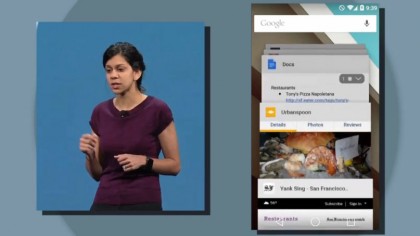Android L: the 10 things you need to know
Google is now living in a Material Design world
6. Chromebook phone notifications
Google's finally looking at ways to link its ChromeOS ambitions with Android a little more deeply, with Android L devices able to tell a Chromebook the user is nearby and have the laptop automatically login -- doing away with the password once again.
Google also demonstrated Chrome OS notifications that can display SMS messages and call details on a Chromebook, also popping up warnings that your nearby phone is running low on battery. Google wants us to start treating Chromebooks like massive Android Wear devices.
This is similar to what Apple is doing with OS X Yosemite and iOS 8 - it's always nice to see two companies coming up with the same idea, isn't it?

7. Enhanced card-like mobile web search results
Google will also completely redesign the Search features within Android L, again bringing more of a Google Now-style cards approach to web searches.
Search results are displayed in a rich card format, complete with animations and shrinking header tabs, with Google proudly claiming it uses 60fps animations to transition between page elements.
An image carousel automatically pulls out visual results, while results related to apps you have installed can instantly open within the relevant app.

8. New Recent Apps list with Chrome tabs
Another fairly huge change to the usual Android way of managing your phone stuff, Android L tweaks the Recent Apps multitasking menu in a couple of ways.
Sign up for breaking news, reviews, opinion, top tech deals, and more.
First is a complete visual overhaul that turns it into more of a rolodex type affair with shadows and perspective elements, while the other change sees recent Chrome tabs appear in the list too.
So if you're looking for a recently visited web page, it'll be right there in your recent stuff list -- making the multitasking menu much more useful.

9. ART the new default for better performance
A huge under-the-bonnet change has also been made, with Google switching from the long-running Dalvik runtime to the experimental ART option that arrived as a slightly-hidden developer option inside Google's previous KitKat release.
To the end user this won't make much or perhaps any difference in the way the phone operates, although Google claims an up to two-times performance boost may be seen in some situations, without developers having to lift a finger or change a line of code.
ART is also more memory efficient, saving megabytes of RAM -- and it's fully 64-bit compatible for future hardware bragging.

10. Separate home and work profiles
Another big pair of introductions should make blagging a nice phone for work a little easier. The Android for Work system allows users to have multiple app instances on one device, separating work app data from home app data.
The certified Android for Work programme is coming in the autumn, with some features also set to appear on devices running software older than the new L-update.
As well as this, Samsung's well thought of Knox workplace security tool is also coming to Android L, with Samsung's tools getting integrated into Google's core code.
- 1
- 2
Current page: Chromebook fun, faster speeds and phones at work
Prev Page New design, Project Volta and more